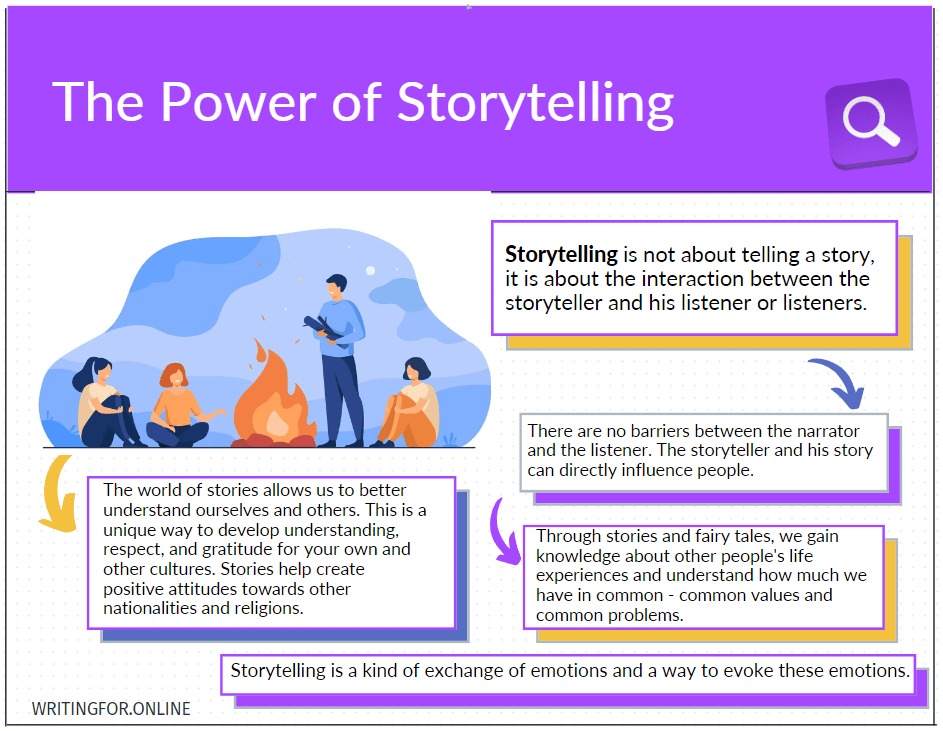In this article, you’ll read about what storytelling is and its impact, why storytelling is still so popular, and who are the main characters of each story.
Table of Contents
- What Is Storytelling
- The Phenomenon of Storytelling Popularity
- The Main Characters of Storytelling: Protagonist and Antagonist
- Different Sides of One Story
What Is Storytelling
Several people are sitting around the fire. Each of them tells a fascinating story about incredible events, brave heroes, great love, suffering, and unbearable grief. The narrator is focused and immersed in the world of the heroes of the story. All you can hear is his voice and the crackling of the fire.

This is the picture that appears in our heads when we hear the word “storytelling”. Only in our time, this picture has changed a lot. If earlier stories were transmitted by one person to another or several people orally, now the sources of stories are the Internet, books, television, films, and TV series.
Definition
Translated, “storytelling” literally means “telling stories.” It is a way to create empathy and establish an emotional connection with your audience.
Through stories and fairy tales, we learn about the social and cultural activities of people. This is a unique way of simply transmitting experience, cultural and moral values, norms of behavior, and a way of teaching these norms of behavior.

Storytelling is not about telling a story, it is about the interaction between the storyteller and his listener or listeners. This is what differentiates storytelling from, for example, theatrical performance. There are no barriers between the narrator and the listener. The storyteller and his story can directly influence people.
Impact of Storytelling
The world of stories allows us to better understand ourselves and others. This is a unique way to develop understanding, respect, and gratitude for your own and other cultures. Stories help create positive attitudes towards other nationalities and religions.
Through stories and fairy tales, we gain knowledge about other people’s life experiences and understand how much we have in common – common values and common problems.
Storytelling is a kind of exchange of emotions and a way to evoke these emotions.
The Phenomenon of Storytelling Popularity
Why is storytelling gaining momentum and increasingly being used in completely different areas of our lives?
The answer is simple: people care about people. We are interested in what happens to other people. It can be compared to watching the television show “The X Factor”. People watch the show not for the sake of beautiful singing, they are interested in learning about the life of each participant, getting to know his personal story, and understanding what kind of person he is. We empathize with some of the participants, sympathize with others, and are angry with others. History is what’s truly interesting!
At Stanford University, studies were conducted on several groups of students. As a result, scientists concluded that people make decisions based on beliefs and principles, rather than facts and evidence.
As an example, we can cite vaccination. No matter how much research is conducted, evidence in favor of vaccination is presented, and rumors are debunked, it does not help in convincing opponents of vaccination.
Another example is the fear of flying on airplanes. People prefer to travel by car; they are afraid to fly. At this point, the brain forgets about car accident statistics. In a person’s head, there are pictures from the news about plane crashes. This is how the human brain works. You can read more about Stanford University research in the New Yorker “Why Facts Don’t Change Our Minds“.
The Main Characters of Storytelling: Protagonist and Antagonist
There are two kinds of characters in every story: the protagonist and the antagonist.
The protagonist (“fighter”) is the main character, who, by the way, is not always positive.
He is opposed by an antagonist (“rival”).
Most often, the main characters are people, but natural phenomena, inanimate objects, and even emotions and ideas can also play the role of protagonist and antagonist.
In addition, each story has its structure:
- an introduction,
- a main part
- and the end.
Different Sides of One Story
The same story can be told from completely different sides. Let’s take an example: there was a car accident. The victim will have his own vision: his car is broken, he is confused and terrified. The person responsible for the accident has his own story: he experiences fear and shame but does not feel guilty, because he was blinded by an oncoming car and unintentionally jerked the steering wheel. The police officer who arrives at the scene of the accident will have his view of the story. The ambulance driver and the witnesses to the accident have their own stories. And only after hearing all these stories will it be possible to draw a conclusion.
The topic is very interesting. There is a lot to think about and write about.
P.S.: If you are interested, share the article on social networks! Bye!